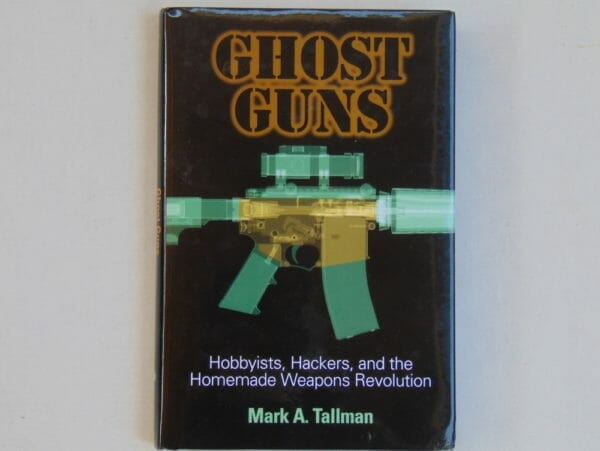
U.S.A. –-(AmmoLand.com)- The new book Ghost Guns by Mark A. Tallman is a very well-researched, well-written book on the topic of homemade, craft, artisanal, and small shop production of firearms, and the implications of the use of advanced technology to facilitate the production of so-called ‘Ghost Guns’.
These firearms are made without the pre-approval of the modern regulatory state.
Ghost Guns by Mark A. Tallman
The research done to write the book is exemplary. This correspondent has followed the subject for over 50 years. The author of the book included all the major sources on the subject, and most minor sources. The effort to find and include all worthwhile sources was impressive, extremely well done. The book is worth reading, simply as a compendium of sources. There are facts and statistics which are very difficult to find elsewhere. The bibliography, listing sources, is 36 pages long.
In the introduction, Tallman presents obvious facts which are often ignored, but crucial to the subject. From the introduction:
p. xv “In reality, guns have been made independently for a thousand years.”
p. xvii “most guns are ghost guns”.
The theme of the book is presented:
p. xx “This book explores the security implications of DIY weapons, the practical aspects of making them, and the wider technological, legal, and civil liberties implications of recalibrating traditional gun controls to address modern DIY.”
The book continues through 235 dense pages. The author gives an excellent history of gun making. He does well in describing the scope of non-regulated gun-making around the world.
The book includes the latest technologies and techniques which are being used to make guns at home and in small shops, including 3-D printing, electrochemical machining, and hybrid designs. The author describes the substitution of weapons and media contagion effects.
On page 98, this obvious, yet seldom mentioned insight is declared:
..the primary controversy isn’t about making guns. It’s about having guns the government doesn’t track and cannot easily confiscate.
The author spends considerable time writing about supply-side laws and regulations, which are designed to prevent people the state does not wish to have guns from obtaining them by restricting and regulating the supply of guns. These include measures such as background checks, gun registration, and licensing of gun makers. There are several references in the book which show these schemes have very limited effect and/or no significant benefit.
Mark A, Tallman works hard at being neutral in his presentation. He deserves credit for his efforts.
Neutrality is impossible to attain.
In spite of the lack of evidence that supply-side controls on guns have been effective or have a favorable cost to benefit ratio, the book assumes they are worthwhile and need to be “improved”.
Unfortunately, Tallman uncritically accepts the base assumption of those who want a disarmed population. On page 105, he states:
“The human costs of gun mortality are undeniable, with 30,000 – 40,000 deaths in typical years.”
There is no serious evidence a statistically significant number of deaths would be eliminated by any supply-side regulatory scheme. Nor is there evidence the number of deaths would be significantly reduced by the current regulatory scheme or would be by an “improved” version. “Gun deaths” is a loaded term.
There is ample evidence no significant effect would be achieved, for several reasons which are referenced in the book. Deaths by guns might be reduced. It does not follow the absolute number of deaths would be reduced. There are numerous other methods that can be substituted for guns. Suicides by gun may drop, but suicides by other methods go up. Criminals find ways to access guns outside of regulatory channels.
Tallman mentions some benefits of gun ownership in passing but fails to consider benefits such as self-defense and limited government power, in his calculus of costs and benefits of current supply-side schemes.
Do more guns in society increase or decrease deaths overall? The best evidence is they have little effect.
Near the conclusion of the book, p. 184, a curious counterfactual argument is presented.
Industrialization led to more guns, but also coincided with massive improvements in science, education, literacy, security, justice, opportunity, political rights, social tolerance, health, economic choice, and quality of life which, barring outliers, outstripped the social costs of more weapons becoming available.
Occam’s Razor would have the availability of firearms intrinsically bound up with the improvements and increase in quality of life, not something which they had to overcome. Such potential is easy to imagine: guns give a significant power advantage to societies that adopt them, thus protecting and facilitating the spread and dominance of industrial societies. Guns equalize power between individuals in a society. Guns can as easily be seen as facilitating security, justice, opportunity, political rights, and social tolerance as being a hindrance to them. The correlation between the wide availability of guns and such advances is clear.
In spite of the issue in the basic assumption about the value of supply-side gun regulation, the book is excellent. This correspondent rates it at 5 stars for content and writing style.
About Dean Weingarten:
Dean Weingarten has been a peace officer, a military officer, was on the University of Wisconsin Pistol Team for four years, and was first certified to teach firearms safety in 1973. He taught the Arizona concealed carry course for fifteen years until the goal of Constitutional Carry was attained. He has degrees in meteorology and mining engineering, and retired from the Department of Defense after a 30 year career in Army Research, Development, Testing, and Evaluation.


